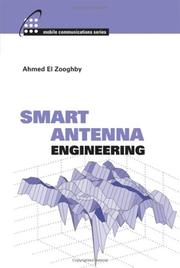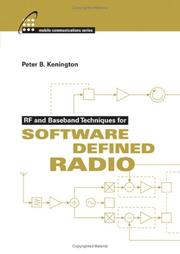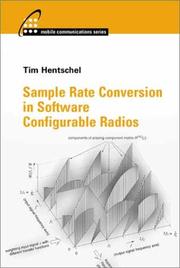| Listing 1 - 10 of 20 | << page >> |
Sort by
|
Book
ISBN: 1523132655 1630814598 9781630814595 9781630814571 1630814571 Year: 2018 Publisher: Boston, Mass. Artech House
Abstract | Keywords | Export | Availability | Bookmark
 Loading...
Loading...Choose an application
- Reference Manager
- EndNote
- RefWorks (Direct export to RefWorks)
Based on the popular Artech House classic, Digital Communication Systems Engineering with Software-Defined Radio, this book provides a practical approach to quickly learning the software-defined radio (SDR) concepts needed for work in the field. This up-to-date volume guides readers on how to quickly prototype wireless designs using SDR for real-world testing and experimentation. This book explores advanced wireless communication techniques such as OFDM, LTE, WLA, and hardware targeting. Readers will gain an understanding of the core concepts behind wireless hardware, such as the radio frequency front-end, analog-to-digital and digital-to-analog converters, as well as various processing technologies. Moreover, this volume includes chapters on timing estimation, matched filtering, frame synchronization message decoding, and source coding. The orthogonal frequency division multiplexing is explained and details about HDL code generation and deployment are provided. The book concludes with coverage of the WLAN toolbox with OFDM beacon reception and the LTE toolbox with downlink reception. Multiple case studies are provided throughout the book. Both MATLAB and Simulink source code are included to assist readers with their projects in the field
Software radio. --- Radio, Reconfigurable --- Radio, Smart --- Radio, Software --- Reconfigurable radio --- SDR (Software-defined radio) --- Smart radio --- Software-based radio --- Software-defined radio --- Wireless communication systems --- Telecommunication technology

ISBN: 1596930683 9781596930681 1580535151 9781580535151 Year: 2005 Publisher: Boston, MA : Artech House,
Abstract | Keywords | Export | Availability | Bookmark
 Loading...
Loading...Choose an application
- Reference Manager
- EndNote
- RefWorks (Direct export to RefWorks)
Whether you are designing for systems based on 2G, 3G, or advanced MIMO technology, you can find the solution you need with this comprehensive reference on applying smart antennas in wireless and mobile communications. The book provides you with a simple yet powerful design methodology that enables you to select the smart antenna approach most suitable for a particular application. Moreover, it offers guidance in designing the appropriate uplink and downlink beamforming algorithms.
Adaptive antennas. --- Software radio. --- Radio, Reconfigurable --- Radio, Smart --- Radio, Software --- Reconfigurable radio --- SDR (Software-defined radio) --- Smart radio --- Software-based radio --- Software-defined radio --- Wireless communication systems --- Antennas (Electronics)

ISBN: 1580537944 9781580537940 1580537936 9781580537933 Year: 2005 Publisher: Boston : Artech House,
Abstract | Keywords | Export | Availability | Bookmark
 Loading...
Loading...Choose an application
- Reference Manager
- EndNote
- RefWorks (Direct export to RefWorks)
Annotation
Software radio. --- Radio circuits --- Circuits, Radio --- Electronic circuits --- Radio, Reconfigurable --- Radio, Smart --- Radio, Software --- Reconfigurable radio --- SDR (Software-defined radio) --- Smart radio --- Software-based radio --- Software-defined radio --- Wireless communication systems --- Design.

ISBN: 1580538029 9781580533362 1580533361 1580533361 9781580538022 Year: 2002 Publisher: Boston Artech House
Abstract | Keywords | Export | Availability | Bookmark
 Loading...
Loading...Choose an application
- Reference Manager
- EndNote
- RefWorks (Direct export to RefWorks)
This authoritative, leading-edge resource gives you a comprehensive overview of sample rate conversion (SRC) and its applications in software configurable radios. The book helps you understand the limits of feasible systems for sample rate conversion, as well as the limits of interpolation. You get sound advice on selecting the appropriate types of SRC for specific applications, and assistance in handling the trade-off between hardware complexity and the clock rate of a system.
Sampling (Statistics) --- Software radio. --- Telecommunication --- Random sampling --- Statistics of sampling --- Statistics --- Mathematical statistics --- Radio, Reconfigurable --- Radio, Smart --- Radio, Software --- Reconfigurable radio --- SDR (Software-defined radio) --- Smart radio --- Software-based radio --- Software-defined radio --- Wireless communication systems --- Traffic --- Management.
Book
ISBN: 1608075265 9781608075263 1608075257 9781608075256 Year: 2013 Publisher: Boston
Abstract | Keywords | Export | Availability | Bookmark
 Loading...
Loading...Choose an application
- Reference Manager
- EndNote
- RefWorks (Direct export to RefWorks)
This unique resource provides you with a practical approach to quickly learning the software-defined radio concepts you need to know for your work in the field. By prototyping and evaluating actual digital communication systems capable of performing over-the-air wireless data transmission and reception, this volume helps you attain a first-hand understanding of critical design trade-offs and issues. Moreover you gain a sense of the actual real-world operational behavior of these systems. With the purchase of the book, you gain access to several ready-made Simulink experiments at the publisher s website. This collection of laboratory experiments, along with several examples, enables you to successfully implement the designs discussed the book in a short period of time. These files can be executed using MATLAB version R2011b or later versions.
Software radio. --- Systems engineering. --- Digital communications. --- Communications, Digital --- Digital transmission --- Pulse communication --- Digital electronics --- Pulse techniques (Electronics) --- Telecommunication --- Digital media --- Signal processing --- Engineering systems --- System engineering --- Engineering --- Industrial engineering --- System analysis --- Radio, Reconfigurable --- Radio, Smart --- Radio, Software --- Reconfigurable radio --- SDR (Software-defined radio) --- Smart radio --- Software-based radio --- Software-defined radio --- Wireless communication systems --- Digital techniques --- Design and construction
Periodical
ISSN: 23126620
Abstract | Keywords | Export | Availability | Bookmark
 Loading...
Loading...Choose an application
- Reference Manager
- EndNote
- RefWorks (Direct export to RefWorks)
cognitive radio --- cognitive radio networks --- dynamic spectrum access --- Radio spectrum --- software defined radio --- spectrum efficiency --- Wireless Internet --- Wireless Internet. --- Internet --- Wireless communication systems --- Telecommunications --- radio spectrum --- Engineering sciences. Technology
Book
ISBN: 9535133381 9535133373 9535147668 Year: 2017 Publisher: IntechOpen
Abstract | Keywords | Export | Availability | Bookmark
 Loading...
Loading...Choose an application
- Reference Manager
- EndNote
- RefWorks (Direct export to RefWorks)
One of the most critical resources required for wireless communication is the radio spectrum. Traditionally, the administration of the spectrum rights tends to grant exclusive rights to some services in the major geographic regions. On the other hand, several studies have shown that the spectrum is actually underutilized and that new devices should use the underutilized spectrum in an opportunistic manner. Cognitive radio is a way to do that. The cognitive radio needs to collect cognition about the radio environment to operate efficiently. Such a radio needs to understand if the spectrum it intends to use is free or utilized by some primary user. By primary user we mean the licensed user of the band, and correspondingly the cognitive radios are often termed as secondary users. The goal of this book is to collect recent research about cognitive radio and provide an up-to-date review of the challenging topic.
Information technology. --- Wireless communication systems. --- Artificial intelligence. --- Software radio. --- Radio, Reconfigurable --- Radio, Smart --- Radio, Software --- Reconfigurable radio --- SDR (Software-defined radio) --- Smart radio --- Software-based radio --- Software-defined radio --- Wireless communication systems --- AI (Artificial intelligence) --- Artificial thinking --- Electronic brains --- Intellectronics --- Intelligence, Artificial --- Intelligent machines --- Machine intelligence --- Thinking, Artificial --- Bionics --- Cognitive science --- Digital computer simulation --- Electronic data processing --- Logic machines --- Machine theory --- Self-organizing systems --- Simulation methods --- Fifth generation computers --- Neural computers --- Communication systems, Wireless --- Wireless data communication systems --- Wireless information networks --- Wireless telecommunication systems --- Telecommunication systems --- IT (Information technology) --- Technology --- Telematics --- Information superhighway --- Knowledge management --- Engineering --- Physical Sciences --- Engineering and Technology --- Electrical and Electronic Engineering --- Wireless Communication System
Book
ISBN: 1282168835 9786612168833 008092316X 0123745357 9780080923161 9780123745354 9781282168831 6612168838 Year: 2009 Publisher: Amsterdam : Academic Press,
Abstract | Keywords | Export | Availability | Bookmark
 Loading...
Loading...Choose an application
- Reference Manager
- EndNote
- RefWorks (Direct export to RefWorks)
This book gives a thorough knowledge of cognitive radio concepts, principles, standards, spectrum policy issues and product implementation details. In addition to 16 chapters covering all the basics of cognitive radio, this new edition has eight brand-new chapters covering cognitive radio in multiple antenna systems, policy language and policy engine, spectrum sensing, rendezvous techniques, spectrum consumption models, protocols for adaptation, cognitive networking, and information on the latest standards, making it an indispensable resource for the RF and wireless engineer.
Software radio. --- Artificial intelligence. --- Wireless communication systems. --- Communication systems, Wireless --- Wireless data communication systems --- Wireless information networks --- Wireless telecommunication systems --- Telecommunication systems --- AI (Artificial intelligence) --- Artificial thinking --- Electronic brains --- Intellectronics --- Intelligence, Artificial --- Intelligent machines --- Machine intelligence --- Thinking, Artificial --- Bionics --- Cognitive science --- Digital computer simulation --- Electronic data processing --- Logic machines --- Machine theory --- Self-organizing systems --- Simulation methods --- Fifth generation computers --- Neural computers --- Radio, Reconfigurable --- Radio, Smart --- Radio, Software --- Reconfigurable radio --- SDR (Software-defined radio) --- Smart radio --- Software-based radio --- Software-defined radio --- Wireless communication systems --- Engineering --- Electronics
Book
ISBN: 1281180130 9786611180133 1402065388 140206537X 9048176638 Year: 2008 Publisher: Dordrecht : Springer,
Abstract | Keywords | Export | Availability | Bookmark
 Loading...
Loading...Choose an application
- Reference Manager
- EndNote
- RefWorks (Direct export to RefWorks)
By the end of this decade, a 4G wireless terminal will be available that provides high quality multimedia, personalized services, and ubiquitous multi-standard broadband connectivity with a reasonable power consumption. In this context, a multi-band transceiver is needed that provides a high-level of programmability while keeping low design complexity and costs. Software Defined Radio (SDR) is the most promising technology to implement such a terminal as it enables multi-mode reception by tuning to any frequency band, by selecting any channel bandwidth, and by detecting any modulation. Baseband Analog Circuits for Software Defined Radio aims to describe the transition towards a Software Radio from the analog design perspective. As the original idea of a "full-digital" Software Radio is far from the state-of-art, an analog front-end is still needed to achieve a feasible implementation. Most of the existent front-end architectures are explored from the flexibility point of view. A complete overview of the actual state-of-art for reconfigurable transceivers is given in detail, focusing on the challenges imposed by flexibility in analog design. As far as the design of adaptive analog circuits is concerned, specifications like bandwidth, gain, noise, resolution and linearity should be programmable. The development of circuit topologies and architectures that can be easily reconfigured while providing a near optimal power/performance trade-offs is a key challenge. In this book, we tackle this challenge mainly for baseband analog circuits, i.e. amplifiers and filters, proposing efficient solutions that provide a high level of programmability. Measurements results validate the design strategies.
Electronic analog computers --- Electronic circuit design. --- Mobile communication systems. --- Software radio. --- Circuits. --- Radio, Reconfigurable --- Radio, Smart --- Radio, Software --- Reconfigurable radio --- SDR (Software-defined radio) --- Smart radio --- Software-based radio --- Software-defined radio --- Wireless communication systems --- Vehicles --- Vehicular communication systems --- Radio --- Electronic circuits --- Analog computer circuits --- Communication systems --- Design --- Telecommunication. --- Systems engineering. --- Communications Engineering, Networks. --- Circuits and Systems. --- Signal, Image and Speech Processing. --- Engineering systems --- System engineering --- Engineering --- Industrial engineering --- System analysis --- Electric communication --- Mass communication --- Telecom --- Telecommunication industry --- Telecommunications --- Communication --- Information theory --- Telecommuting --- Design and construction --- Electrical engineering. --- Electronic circuits. --- Signal processing. --- Image processing. --- Speech processing systems. --- Computational linguistics --- Electronic systems --- Modulation theory --- Oral communication --- Speech --- Telecommunication --- Singing voice synthesizers --- Pictorial data processing --- Picture processing --- Processing, Image --- Imaging systems --- Optical data processing --- Processing, Signal --- Information measurement --- Signal theory (Telecommunication) --- Electron-tube circuits --- Electric circuits --- Electron tubes --- Electronics --- Electric engineering
Book
Year: 2022 Publisher: MDPI - Multidisciplinary Digital Publishing Institute
Abstract | Keywords | Export | Availability | Bookmark
 Loading...
Loading...Choose an application
- Reference Manager
- EndNote
- RefWorks (Direct export to RefWorks)
In recent years, microwave sensing and imaging have acquired an ever-growing importance in several applicative fields, such as non-destructive evaluations in industry and civil engineering, subsurface prospection, security, and biomedical imaging. Indeed, microwave techniques allow, in principle, for information to be obtained directly regarding the physical parameters of the inspected targets (dielectric properties, shape, etc.) by using safe electromagnetic radiations and cost-effective systems. Consequently, a great deal of research activity has recently been devoted to the development of efficient/reliable measurement systems, which are effective data processing algorithms that can be used to solve the underlying electromagnetic inverse scattering problem, and efficient forward solvers to model electromagnetic interactions. Within this framework, this Special Issue aims to provide some insights into recent microwave sensing and imaging systems and techniques.
MW magnetic field --- axial ratio --- polarization --- NV center --- two-dimensional radar imaging --- multiple-input multiple-output (MIMO) radar --- Particle Swarm Optimization (PSO) --- imaging plane calibration algorithm (IPCA) --- microwave tomography --- stroke detection --- DBIM --- linearized inverse scattering --- microwave imaging --- orbital angular momentum --- born approximation --- rytov approximation --- brain stroke --- monitoring --- antenna array --- electromagnetic scattering --- buried objects --- through-wall radar --- inverse scattering --- breast --- multipath --- dynamic range --- software defined radio --- leakage --- frequency-dimension scale --- terahertz --- measurements --- differential imaging --- numerical optimization --- block system inversion --- trade-off analysis --- medical MEMS --- wireless power transfer --- microwave --- thermography --- field illustration --- permittivity --- radar imaging --- target detection --- experimental measurements --- imaging --- wave propagation --- beam summation methods
| Listing 1 - 10 of 20 | << page >> |
Sort by
|

 Search
Search Feedback
Feedback About UniCat
About UniCat  Help
Help News
News